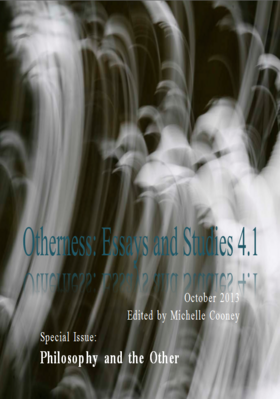
The papers in this special issue of the journal ‘Otherness: Essays and Studies’ consider the topic of Philosophy and the Other. The articles included explore the concept of Otherness using diverse philosophical critique as the backdrop to their interpretation and point to a problem that, like many fundamental problems in philosophy, is at once strikingly contemporary and classical: how can we account for the place of the Other in human experience, when the polyphonic social sciences that have emerged from experience to study the other seem unable to situate Otherness?
The question of the Other fascinates philosophy and gives rise to such questions such as: What does it mean to be other than the self? How do I and must I relate to the other? Is there the possibility of the absolute Other and if so how does this problematise identity? The papers included here provide striking examples of the proximity and the relativity of the concept of Otherness and highlight that any concept of the Other must be properly articulated in order to address the ethical and epistemological concerns that characterise the concept.
The contributors to this journal have adopted various approaches to the topic of Philosophy and the Other, highlighting amongst other things that there is no constant concept of the other which underlies philosophical studies. Clancy Smith clearly maps out Peirce’s account of the other (social individualism) in the context of his fallibilist methodology. Of particular interest is the account given of the primacy attributed by Peirce to the social in language, belief construction and knowledge acquisition, such that – in opposition to the Cartesian conception of the solitary ego which has so distorted modernist thought – the very conception of the self is argued to have meaning only by reference to community membership.
Barbara Leung’s paper concentrates on an examination of the framing of the Armenian Genocide in National Geographic in order to uncover as to whether or not this framing is accurate questions the influence that institution (in this case, National Geographic) plays in collecting these “records”. Vera Alexander, on the other hand, examines confrontations with nature's otherness. She proposes a reading of gardens as sites of non-human Otherness: devoid of intent or agency, they are alive, and illustrates how human beings enter into a relationship with them.
An account of Gadamer’s dialogical “fusion of horizons” as representing an ontology in which the “other” is recognised as constitutive in the formation of meaning is provided by Cynthia Nielsen. Cynthia does this through an analysis of Charles Taylor’s essay on Gadamer and through an examination of finitude and incommensurability. Bernardo Ferro’s paper provides an exegesis on Hegel’s description of the formation of self-consciousness in the Phenomenology of Spirit. In it he extrapolates on the necessity of the dialectic of self-same/other in the establishment of the identity through difference through which self –consciousness is constituted and argues that this is a continuous process rather than the establishment of a static identity.
The question of phenomenological intersubjectivity in art and culture is addressed by Amanda Sarasein, wherein she suggests that the self-other binary that categorises culture is based upon a Cartesian conception of identity and therefore ignores the intersubjectivity of Being that arises out of human embodiment. Amanda draws upon phenomenological theories to conclude an inherent intersubjectivity which renders all cultures essentially connected through the very memes (and cultural products of these memes) which are often taken to define that particular culture as distinct.
Christine Evans examines the flaws in Emmanuel Levinas’ popular theory of responsibility for the Other and the consequences of these re-readings on contemporary conceptions of global justice, otherness, and the figure of the neighbor, drawing upon the theories of Slavoj Žižek and Kierkegaard and subsequent interpretations of modern popular films.
An attempt to bring into focus a philosophical methodology for engaging with the other across the conceptual incommensurability of the difficult pedagogical relationship between equality and freedom, is undertaken by Cathrine Ryther. Specifically, her article aims to describe her method of constructing complicated conversations between Jacques Rancière’s logic of equality and Adriana Cavarero’s prioritization of uniqueness.
In their paper, Yochai Ataria and Eli Somer present the analysis of an in-depth interview with a sixty year-old woman with Dissociative Identity Disorder (DID), in which it is demonstrated that the experience of DID has many attributes in common with total otherness phenomenon. This interview opens a crack in the world of an individual who feels the total other andreveals some fundamental features of the other, including loss of the first-person perspective upon the world, robot-like feelings, disconnection from one's body and the world, unbearable inner conflicts, and self-loathing that results in being the Total Other.
Matthew Harris’ insightful paper tackles Vattimo’s (under the influence of Heidegger and Gadamer) methodology for an approach to otherness that resists metaphysics and its transcendent absolutes and clearly distinguishes between ideas of Otherness and otherness. In contrast, perhaps, Ian Dillon’s paper offers an insightful and expansive treatment of the other from a democratic perspective, touching on its Greek origins whilst focusing primarily on an existential politics and developments thereon as recently as the last decade.
One thing that is apparent from the diverse range of papers here that if the problem of the Other is not to remain completely intractable then we must conclude that any dominant philosophical conceptions of either self, other, sameness and otherness will have to be radically examined (as initiated by several papers in this volume). It is in this nexus of seemingly intractable philosophical dead-ends that the papers in this special issue boldly attempt to navigate a path that is neither homogenous nor enclosed. The papers in this volume were a response to an invitation to address the questions posed by a concept of Philosophy and the Other and I am grateful to the contributors for accepting the challenge and making such significant inroads into this philosophical dilemma.
And now, in the spirit of philosophy: to the papers themselves!
Many thanks to our contributors.